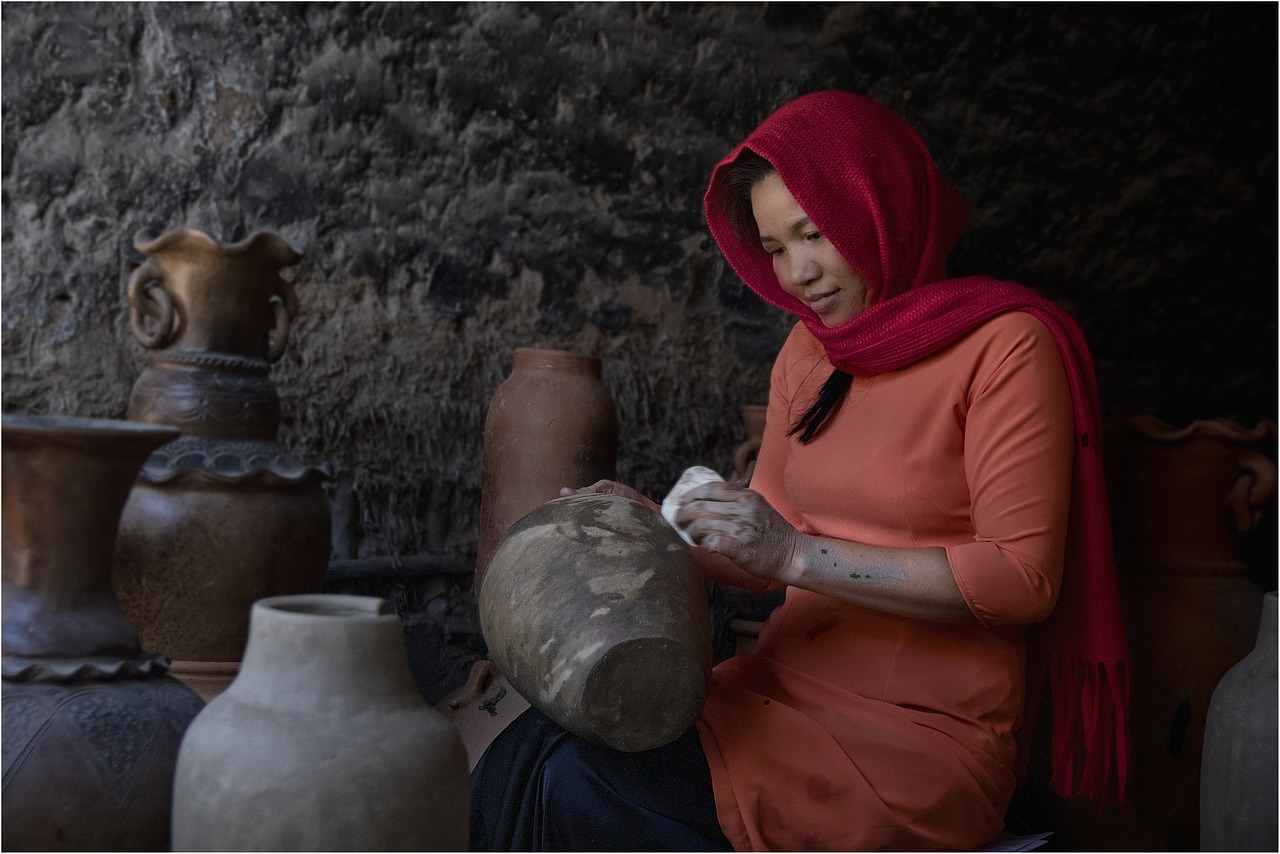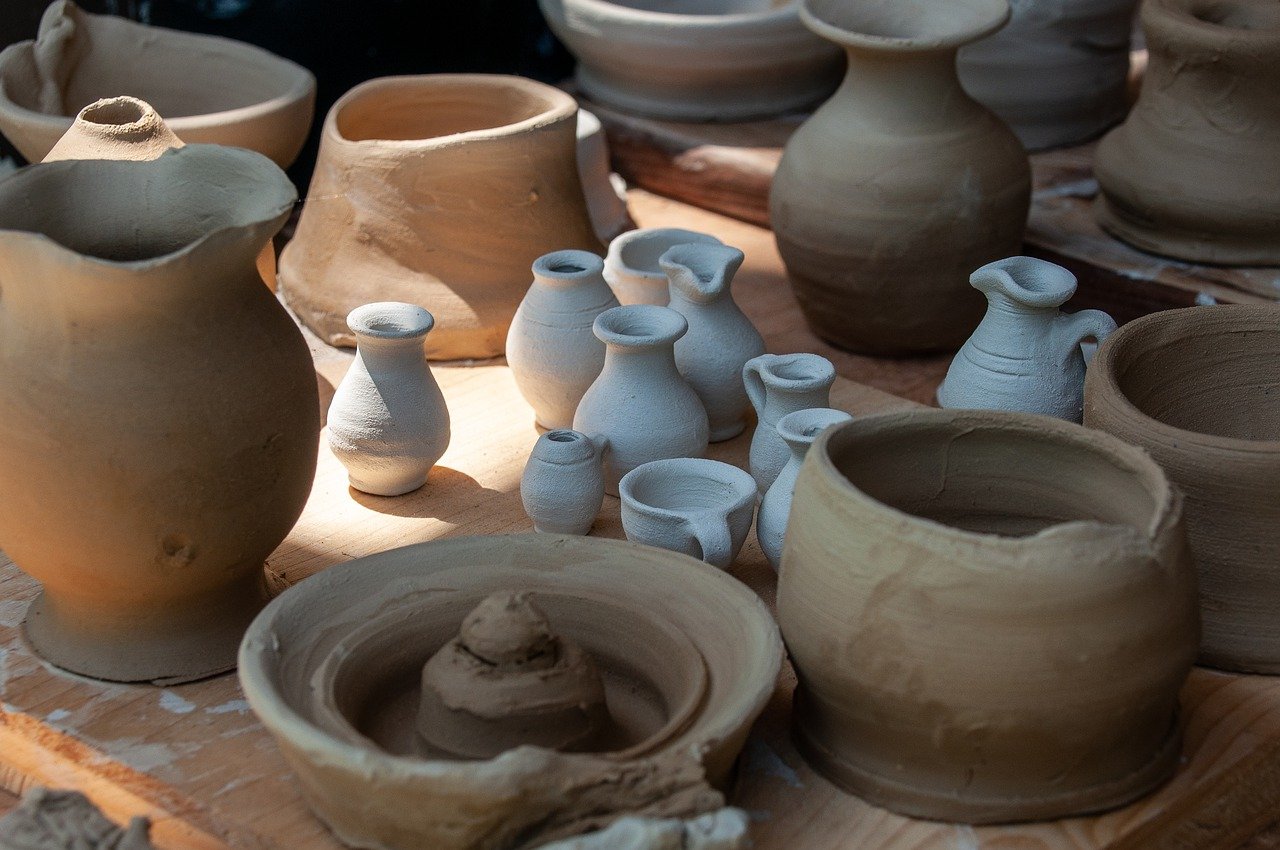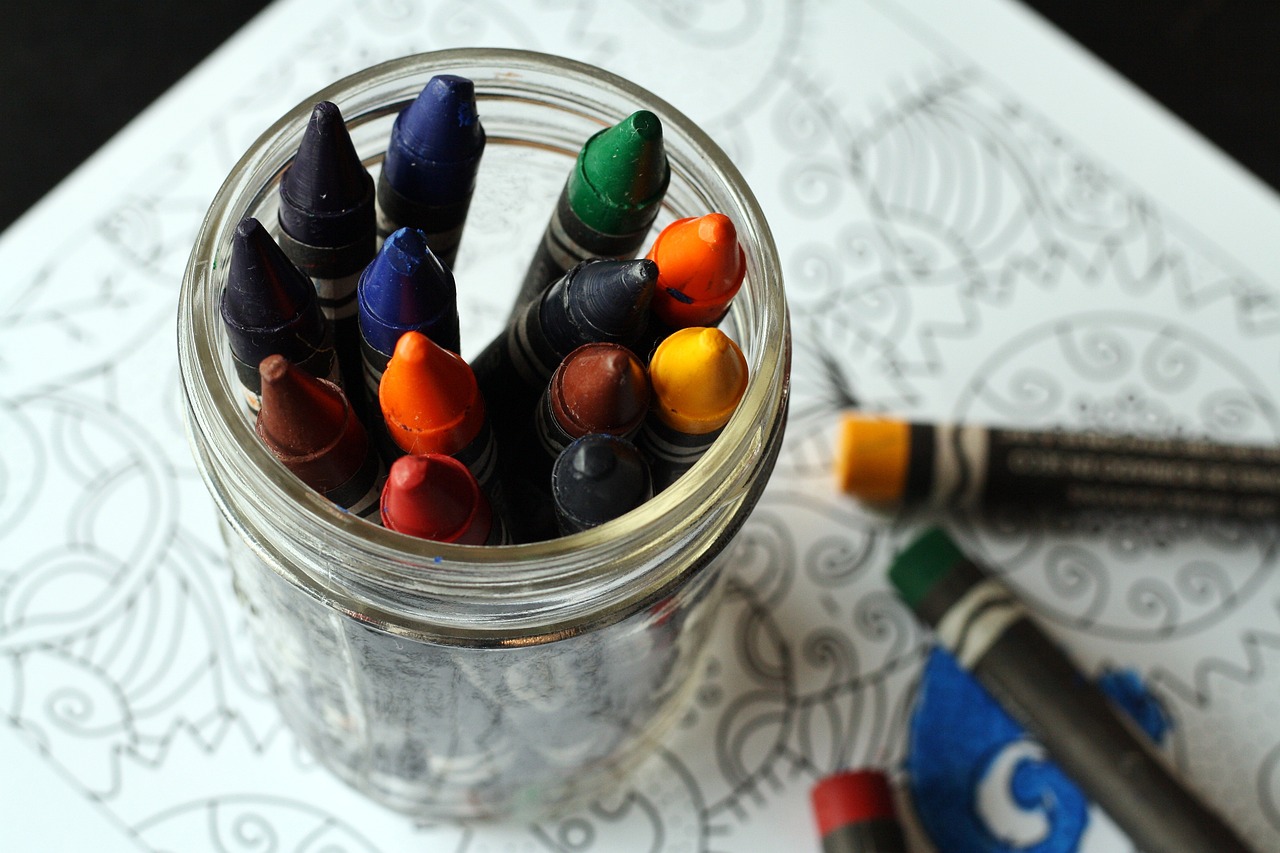The Best Art Books for Young Kids who Love to Craft
Are you ready to dive into the colorful world of creativity with your little ones? If your child has a passion for crafting, then you’re in for a treat! This article explores a selection of engaging art books specifically designed for young children interested in crafting, fostering creativity, and developing artistic skills through fun projects and activities. These books not only provide step-by-step instructions but also inspire kids to unleash their imagination. Let's embark on this artistic journey together!
Every young artist deserves the chance to explore their creative potential. In this section, we’ll discover various artistic techniques tailored for young kids. Think of it as a treasure map leading them to different mediums like painting, drawing, and collage. Each technique enhances not just their fine motor skills but also their creativity. Imagine your child’s excitement as they dip their brush into vibrant colors or tear up bits of paper to create a stunning collage! These activities are more than just fun; they are essential building blocks for artistic development.
Now that we’ve sparked their interest, let’s dive into a variety of fun and easy craft projects that kids can undertake. Each project comes with simple, step-by-step instructions and a list of materials needed, ensuring successful and enjoyable crafting experiences. Whether it’s making a homemade greeting card or creating a colorful paper mache animal, these projects are designed to keep kids engaged and excited. Just picture the joy on their faces when they complete their masterpieces!
What better way to celebrate the changing seasons than with seasonal craft ideas? These projects align with holidays and nature, allowing kids to engage with the world around them. For instance, during spring, they can create flower crowns using fresh blooms or paint vibrant eggs for Easter. In contrast, winter might inspire them to craft snowflakes or festive ornaments. These activities not only foster creativity but also help children appreciate the beauty of each season.
Spring and summer are bursting with inspiration! Highlighting vibrant craft projects, this section provides endless ideas for outdoor activities and nature-themed creations. Kids can gather leaves, flowers, and other natural materials to create stunning art pieces. Imagine them using twigs to make a bird feeder or painting rocks to decorate your garden! These projects encourage kids to connect with their environment while having a blast.
As the temperature drops, it’s time to cozy up with some fall and winter crafts. Incorporating seasonal materials like pinecones, acorns, and colorful leaves, these projects are perfect for indoor activities during colder months. Think of making a warm, fuzzy scarf or creating a stunning centerpiece for Thanksgiving. These crafts not only keep kids engaged but also help them express their creativity while embracing the spirit of the season.
When it comes to nurturing young artists, it’s essential to have the right resources. Learning about art books suitable for various age groups ensures that each child finds the right level of challenge and inspiration. Whether your child is a toddler just starting to explore colors or an older kid ready to tackle more complex projects, there’s a perfect book out there. These books serve as guides, providing not just instructions but also encouraging stories that ignite the passion for art.
Art should never be confined to just a few hours a week; it’s a wonderful way to weave creativity into daily routines. Discussing practical ways to integrate art into everyday life encourages kids to express themselves through simple activities. From doodling during breakfast to crafting homemade cards for friends, these little moments can make art a natural part of their lives. Imagine how fulfilling it is for children to see their creativity reflected in their daily activities!
Setting up a dedicated art space at home can be a game-changer for young artists. Think of it as their personal creative sanctuary, equipped with essential supplies and tools. Tips for creating this space include organizing materials in a way that’s easily accessible and inviting. Bright colors, comfortable seating, and plenty of natural light can transform any corner into an inspiring environment that sparks creativity and exploration!
Lastly, it’s crucial to encourage kids to express themselves artistically. Emphasizing the importance of free expression, experimentation, and the joy of creating without fear of judgment fosters a healthy creative mindset. Allow them to explore different styles and mediums, and remind them that there’s no right or wrong in art. Just like a bird soaring through the sky, they should feel free to spread their wings and let their creativity fly!
Q: What age group are these art books suitable for?
A: The art books mentioned cater to a wide range of ages, from toddlers to early teens, ensuring that every child finds something suitable for their skill level.
Q: How can I encourage my child to be more creative?
A: Providing them with various art supplies, allowing for free expression, and integrating art into daily activities can significantly boost their creativity.
Q: Are there any online resources for art projects?
A: Yes! Many websites offer free tutorials, videos, and downloadable templates for kids to explore various art projects at home.

Creative Techniques for Young Artists
When it comes to nurturing the budding creativity of young artists, exploring various artistic techniques is key. These techniques not only help children express themselves but also enhance their fine motor skills and boost their confidence. Imagine a world where a simple brushstroke can transform a blank canvas into a vibrant landscape or a few crayons can bring a story to life! That's the magic of art, and it’s essential to introduce kids to a variety of methods to keep their imaginations flowing.
One of the most exciting aspects of art is the opportunity to experiment with different mediums. For instance, kids can dive into the world of painting, where they can use watercolors, acrylics, or even finger paints to create masterpieces. The sensation of mixing colors and watching them blend together is not only fun but also educational. It teaches them about color theory and encourages them to think critically about their choices.
Another fantastic technique is drawing. This can be as simple as using a pencil and paper or as adventurous as chalk on the sidewalk. Drawing allows children to express their thoughts and feelings visually. They can start with basic shapes and gradually move on to more complex figures. Encourage them to draw from life—perhaps a favorite toy or a pet. This practice sharpens their observational skills and helps them appreciate the details in their surroundings.
Collage-making is another engaging technique that combines various materials. Kids can cut out pictures from magazines, use fabric scraps, or incorporate natural elements like leaves and flowers. This not only fosters creativity but also teaches them about composition and layering. When they create a collage, they're essentially telling a story through their choices, which is a powerful form of expression.
To further enrich their artistic journey, consider introducing mixed media projects. This technique allows children to combine different materials and methods in one piece. For example, they might paint a background, add a collage element, and then finish with some drawing. The possibilities are endless! This approach encourages experimentation and helps them understand that there are no strict rules in art—only opportunities to create.
As they practice these techniques, it’s important to emphasize the joy of the process rather than the final product. Remind them that every artist has their unique style, and it’s perfectly okay to make mistakes. After all, some of the best artworks come from unexpected accidents! By creating a safe space for exploration, you’re helping them build a foundation for a lifelong love of art.
To summarize, encouraging young artists to explore different techniques is vital for their development. Here’s a quick overview of some techniques that can inspire creativity:
| Technique | Description | Benefits |
|---|---|---|
| Painting | Using various paints such as watercolors and acrylics. | Enhances color theory understanding and fine motor skills. |
| Drawing | Creating images using pencils, markers, or chalk. | Improves observational skills and self-expression. |
| Collage | Combining different materials to create a layered artwork. | Encourages storytelling and composition skills. |
| Mixed Media | Using multiple techniques and materials in one piece. | Fosters experimentation and creativity. |
By embracing these creative techniques, young artists will not only hone their skills but also cultivate a deep appreciation for the arts. So, grab those paints, pencils, and scissors, and let the artistic journey begin!
Q: What age is appropriate to start introducing art techniques to my child?
A: You can start as early as toddlerhood! Simple activities like finger painting or coloring can spark interest. As they grow, you can introduce more complex techniques.
Q: How do I encourage my child if they feel frustrated with their art?
A: Remind them that art is about self-expression, not perfection. Encourage them to take breaks and return to their work with fresh eyes. Celebrate their effort rather than the outcome!
Q: Are there specific materials I should provide for my young artist?
A: Basic supplies like crayons, markers, watercolor paints, and paper are great starting points. As they progress, consider adding more diverse materials like pastels, fabric, and natural elements for collage-making.

Fun Craft Projects to Try
When it comes to sparking creativity in young kids, nothing beats the joy of hands-on crafting. Craft projects are not only fun but also provide a fantastic way for children to express themselves and develop their fine motor skills. Imagine your little ones getting their hands messy with paint or glue, their faces lighting up with every completed project! Here are some exciting craft ideas that will keep your kids engaged and entertained while they explore their artistic talents.
One of the most rewarding aspects of crafting is the range of projects available, suitable for different skill levels and interests. For example, you might start with simple paper crafts, which can be as easy as making paper plate animals or creating colorful collages from magazine cutouts. These projects require minimal supplies and can be completed in a short amount of time, making them perfect for young children with shorter attention spans.
For those looking to dive deeper into creativity, consider introducing your kids to DIY jewelry making. Using beads, strings, and other embellishments, children can create their very own necklaces, bracelets, or even keychains. This not only encourages creativity but also helps with hand-eye coordination. Plus, they get to wear or gift their creations, adding a personal touch to their artistic endeavors!
Another fantastic project is homemade greeting cards. Kids can use colored paper, stickers, and markers to design unique cards for family and friends. This project is especially fun around holidays or birthdays, as children can create personalized greetings that carry their special touch. Imagine the joy of receiving a card made by your little one—it's a treasure that anyone would cherish!
In addition to these ideas, seasonal crafts can also provide a wonderful opportunity for kids to connect with nature and celebrate various occasions. For instance, during the spring, kids can collect flowers and leaves to make beautiful nature collages. In the fall, they might enjoy creating pumpkin decorations using paper, paint, and even real mini-pumpkins! These projects not only enhance their crafting skills but also teach them to appreciate the beauty of each season.
To help you get started, here’s a quick overview of some fun craft projects along with the materials you’ll need:
| Craft Project | Materials Needed | Skill Level |
|---|---|---|
| Paper Plate Animals | Paper plates, markers, googly eyes, glue | Easy |
| DIY Jewelry Making | Beads, string, scissors | Medium |
| Homemade Greeting Cards | Colored paper, stickers, markers, scissors | Easy |
| Nature Collages | Leaves, flowers, glue, paper | Medium |
| Pumpkin Decorations | Mini pumpkins, paint, glue, decorations | Easy |
With these fun and easy craft projects, your kids will not only enjoy the process of creating but also develop a sense of accomplishment as they complete each project. Remember, the goal is to have fun and encourage their imagination, so let them explore and express their creativity freely!
- What age is appropriate for these craft projects? Most of these projects are suitable for children aged 3 and up, with varying levels of supervision and assistance.
- Do I need specialized materials? No! Most of the materials can be found around the house or at local craft stores.
- How can I encourage my child if they get frustrated? Remind them that the process is more important than the outcome. Celebrate their efforts and creativity!

Seasonal Craft Ideas
Crafting is a fantastic way for kids to express their creativity while celebrating the changing seasons. Each time the earth transforms, it brings new inspiration for artistic projects that can be both fun and educational. Imagine the vibrant colors of autumn leaves or the soft pastels of spring flowers—these natural elements can become the basis for exciting craft ideas that help children connect with nature. Whether it’s a chilly winter afternoon or a sunny summer day, there’s always a craft waiting to be made!
For spring and summer, consider projects that utilize the beauty of blooming flowers and the warmth of the sun. Kids can create a flower press to preserve their favorite blossoms. Simply gather flowers, place them between the pages of a heavy book, and wait a few weeks. Once dried, these flowers can be used to make beautiful cards or collages. Another delightful idea is to make suncatchers using clear plastic plates, colorful tissue paper, and glue. These can be hung in windows to catch the sunlight, casting colorful patterns around the room.
As the leaves begin to change and fall, the autumn months present another plethora of crafting opportunities. Kids can create leaf rubbings by placing leaves under a piece of paper and rubbing crayons over them to reveal their intricate patterns. This project not only teaches children about different leaf shapes but also enhances their fine motor skills. Another engaging activity is to gather acorns, pinecones, and other natural materials to make nature sculptures. With a little glue and imagination, children can create whimsical creatures or abstract art pieces that showcase their creativity.
When winter arrives, it’s time to cozy up indoors and craft away! One popular project is making holiday ornaments using salt dough. Kids can help mix the ingredients, roll out the dough, and shape it into festive designs. Once baked and cooled, they can be painted and hung on the Christmas tree or given as gifts to family and friends. Additionally, creating winter wonderland scenes using cotton balls, glitter, and construction paper can spark their imagination. These scenes can reflect the beauty of snow-covered landscapes and the joy of the holiday season.
Incorporating seasonal crafts into your child’s routine not only enhances their artistic skills but also deepens their appreciation for the world around them. By celebrating the unique characteristics of each season, children learn to observe and interact with their environment in a creative way. So, gather your supplies, unleash your imagination, and dive into the wonderful world of seasonal crafting!
Q: What materials do I need for seasonal crafts?
A: Common materials include construction paper, glue, scissors, markers, paint, and natural items like leaves and flowers. Always have a variety of supplies on hand to encourage creativity!
Q: How can I encourage my child to be more creative with their crafts?
A: Allow them to experiment with different materials and techniques. Provide them with prompts or themes but let them take the lead in their creative process. Celebrate their unique creations!
Q: Are seasonal crafts suitable for all age groups?
A: Absolutely! You can adapt projects to suit different ages by simplifying or adding complexity to the tasks involved. Always supervise younger children with materials like scissors and glue.

Spring and Summer Crafts
As the flowers bloom and the sun shines brighter, spring and summer become the perfect backdrop for unleashing your child's creativity through a variety of fun and engaging craft projects. These seasons not only inspire vibrant colors and lively themes but also provide an opportunity for kids to connect with nature and express themselves artistically. Imagine your little ones crafting colorful flower crowns or creating playful sun catchers that dance in the sunlight! The beauty of spring and summer crafts lies in their ability to combine artistic expression with the joys of the great outdoors.
One fantastic project to kick off the season is making a nature collage. Gather materials like leaves, petals, and twigs during a family walk in the park. Once you’ve collected a variety of items, let your kids glue them onto a piece of cardboard to create a stunning piece of art that reflects the beauty of the natural world. This project not only enhances their artistic skills but also teaches them to appreciate the environment around them.
Another exciting idea is to create DIY bird feeders. Using simple materials like pine cones, peanut butter, and birdseed, kids can craft their very own feeders to hang in the backyard. Here’s a quick rundown of the steps:
- Gather a pine cone, peanut butter, and birdseed.
- Spread peanut butter all over the pine cone.
- Roll the pine cone in birdseed until well coated.
- Attach a string to hang it outside.
This project not only provides a fun crafting session but also encourages kids to observe the birds that come to visit their handiwork. It’s a wonderful way to blend art with nature and instill a sense of responsibility towards wildlife.
For those particularly sunny days, why not dive into some outdoor painting? Set up a canvas in your backyard and let your kids go wild with non-toxic paints. They can create abstract art inspired by the colors of the summer sky or even paint a mural on a large piece of cardboard. This not only fosters their creativity but also allows them to enjoy the fresh air and sunshine while they work.
Lastly, don’t forget about the joy of tie-dyeing! This classic summer craft is a hit with kids of all ages. All you need are some plain white t-shirts, fabric dye, and rubber bands. Kids can create their own unique patterns and designs, resulting in wearable art that they can proudly showcase. The process of seeing the colors blend and swirl is nothing short of magical, making it an unforgettable experience for young artists.
In summary, spring and summer crafts offer a wonderful opportunity for kids to explore their creativity while connecting with nature. Whether it’s making a nature collage, crafting bird feeders, outdoor painting, or tie-dyeing, each activity is a chance for children to express themselves and create lasting memories. So grab those supplies and let the crafting adventures begin!

Fall and Winter Crafts
As the leaves turn golden and the air becomes crisp, fall and winter present the perfect backdrop for a plethora of creative crafting opportunities. These seasons not only inspire a change in nature but also ignite the imagination of young artists eager to express themselves. Imagine the joy of creating colorful leaf rubbings in the fall, or the excitement of making festive decorations for winter holidays. Each project not only enhances artistic skills but also fosters a deeper connection to the beauty of the changing seasons.
One delightful craft idea is to create nature-inspired collages. Gather fallen leaves, acorns, and twigs during a nature walk, and encourage kids to arrange these items on a canvas or sturdy paper. This hands-on activity not only boosts their creativity but also teaches them about the environment and the materials they can find outdoors. Plus, it’s a fantastic way to spend quality time together as a family, exploring the wonders of nature.
When winter rolls in, the crafting possibilities become even more magical. Consider making holiday ornaments using simple materials like salt dough or paper. Kids can roll out the dough, cut it into fun shapes, and decorate them with paint or glitter. Not only will these ornaments brighten up your home, but they also make wonderful gifts for friends and family. The process of creating something special adds a personal touch that store-bought items simply can’t match.
Another cozy indoor activity is to create handmade greeting cards. As the holidays approach, kids can design cards for various occasions, such as Thanksgiving, Christmas, or New Year’s. Using colored paper, stamps, and markers, they can let their creativity flow, writing heartfelt messages to loved ones. This not only encourages artistic expression but also teaches them the joy of giving and sharing their creations with others.
To keep the crafting spirit alive during the colder months, consider setting up a seasonal crafting corner at home. Fill it with supplies like colored paper, scissors, glue, and seasonal decorations. Having a dedicated space encourages kids to explore their creativity whenever inspiration strikes. It’s like having a little art studio right at home! You could even create a seasonal calendar that highlights different projects for each month, ensuring that crafting remains a fun and engaging activity throughout the year.
In summary, fall and winter crafts offer a fantastic way for young kids to explore their creativity while celebrating the beauty of the seasons. From nature-inspired collages to festive ornaments and heartfelt greeting cards, these projects not only enhance artistic skills but also create lasting memories. So, gather your supplies, embrace the seasonal spirit, and let the crafting adventures begin!
Q: What materials do I need for fall and winter crafts?
A: Basic materials include colored paper, scissors, glue, paint, and natural items like leaves and twigs. Seasonal decorations like glitter and ribbons can also add flair!
Q: How can I encourage my child to be more creative?
A: Provide a variety of materials and allow them to explore freely. Encourage them to express their ideas without fear of making mistakes. Celebrate their creations, no matter how simple!
Q: Are there any safety tips for crafting with young kids?
A: Always supervise children with sharp tools like scissors, and use non-toxic materials. Make sure the crafting area is safe and comfortable for them to work in.

Art Books for Different Age Groups
When it comes to nurturing creativity in young artists, selecting the right art books for their age group is crucial. Each stage of childhood comes with its unique set of interests and abilities, and the right book can make all the difference in sparking a child's imagination. For toddlers, vibrant picture books that combine simple shapes and colors can captivate their attention, while preschoolers may benefit from interactive books that encourage them to touch and feel different textures. As children progress into early elementary school, they often seek more structured projects that challenge their growing skills.
Here’s a quick overview of some recommended art books tailored to various age groups:
| Age Group | Book Title | Description |
|---|---|---|
| 2-4 Years | My First Art Book | A colorful introduction to art concepts with simple activities that engage toddlers. |
| 4-6 Years | Creative Kids: Fun with Art | Interactive projects that allow preschoolers to explore their creativity through hands-on activities. |
| 6-8 Years | Art for Kids: Drawing and Painting | A guide filled with step-by-step instructions for drawing and painting that encourages self-expression. |
| 8-12 Years | The Big Book of Art for Kids | A comprehensive resource that covers various mediums and techniques, perfect for budding artists. |
As you can see, the diversity of art books available caters to the evolving needs of children as they grow. For instance, toddlers thrive on bright illustrations and simple concepts that allow them to explore art through their senses. On the other hand, older children benefit from books that not only teach them techniques but also inspire them to create original pieces. Each book serves as a stepping stone in their artistic journey, helping them build confidence and skills.
Moreover, it’s essential to consider the interests of the child when selecting an art book. Some kids might be drawn to painting, while others may prefer crafting or drawing. By aligning the art book with their preferences, you can significantly enhance their engagement and enjoyment. Remember, the goal is to make art a fun and integral part of their lives, allowing them to express themselves freely and creatively.
In conclusion, choosing the right art book is about more than just age; it’s about fostering a love for creativity and self-expression. So next time you’re on the hunt for an art book, think about the child’s age, interests, and what skills you want to nurture. The perfect book can inspire a lifelong passion for art!
- What age is appropriate to start introducing art books to my child?
It's best to start as early as 2-3 years old with simple, colorful books that engage their senses. - How can I encourage my child to explore art beyond books?
Set up a dedicated art space at home, provide various materials, and join them in creative activities to foster their interest. - Are there specific themes in art books that can help with learning?
Yes! Look for books that incorporate themes like nature, seasons, or famous artists to enhance both creativity and knowledge.

Incorporating Art into Everyday Life
Art isn't just a subject to be studied in school; it can be a vibrant part of our everyday lives! Imagine waking up in the morning and finding inspiration in the simplest things around you. From the colors of the sunrise to the textures of the leaves outside, every moment holds the potential for artistic expression. By incorporating art into daily routines, we can encourage young kids to explore their creativity in a fun and engaging way.
One of the best ways to integrate art into everyday life is by turning mundane tasks into creative opportunities. For instance, while cooking, children can help create colorful fruit salads or decorate cupcakes with icing. This not only makes the activity more enjoyable but also allows them to experiment with colors and shapes. Additionally, during grocery shopping, parents can challenge kids to pick out fruits and vegetables based on their colors, shapes, or even textures, turning a simple errand into an artistic adventure.
Another fantastic way to incorporate art is through storytelling. Encourage kids to illustrate their favorite stories or even create their own. This could be as simple as drawing characters on a piece of paper or crafting puppets from socks and paper bags. When they see their stories come to life, it ignites a spark of creativity that can inspire them to create even more. The key is to make art a natural part of their lives, so they don't see it as a chore, but rather as an exciting opportunity to express themselves.
To further enhance this creative environment, consider setting up an art corner in your home. This space should be inviting and stocked with various art supplies like crayons, paints, and recycled materials. Having a dedicated area where kids can unleash their creativity whenever they feel inspired is crucial. It’s like having a mini studio at home! You can even involve them in the process of decorating this space, allowing them to personalize it with their artwork. This not only fosters creativity but also gives them a sense of ownership.
Lastly, don't forget to celebrate their creations! Display their artwork around the house, whether on the fridge, in frames, or on a dedicated art wall. This not only boosts their confidence but also reinforces the idea that their artistic expressions are valued. When kids see their work appreciated, they are more likely to continue exploring their creativity. Remember, the goal is to create an environment where art feels accessible and fun, making it a natural part of their daily lives.
Q: How can I encourage my child to be more creative?
A: Encourage creativity by providing them with various materials and opportunities to express themselves. Engage them in activities that allow for free expression, such as painting, drawing, or crafting.
Q: What supplies should I have for my child's art corner?
A: Essential supplies include crayons, markers, colored pencils, paints, brushes, paper, glue, scissors, and recycled materials like cardboard and fabric scraps.
Q: How can I make art a part of our family routine?
A: Incorporate art into family activities, such as cooking, gardening, or storytelling. Set aside specific times for art projects and encourage collaborative creations.
Q: What if my child is hesitant to try new art techniques?
A: Encourage them to experiment without fear of mistakes. Offer gentle guidance and praise their efforts, emphasizing that the process is more important than the final product.

Creating an Inspiring Art Space
When it comes to nurturing creativity in young artists, the environment plays a crucial role. An inspiring art space can transform a simple room into a vibrant haven where imagination runs wild. Think of it as a blank canvas waiting for the splash of colors that your child will bring. So, how do you go about creating this magical space? Let’s dive into some practical tips!
First off, consider the location. Ideally, the art space should be in a place where your child feels comfortable and free to express themselves. This could be a corner of their bedroom, a section of the living room, or even a dedicated art room if you have the space. The key is to choose an area that is well-lit, preferably with natural light streaming in, as it can significantly enhance the mood and inspire creativity.
Next, think about the supplies and tools. Stocking up on a variety of art materials is essential. Here’s a quick checklist of must-have supplies:
- Colored pencils and crayons
- Watercolors and brushes
- Markers and pastels
- Glue, scissors, and tape
- Various types of paper (construction, watercolor, etc.)
- Recyclable materials (like cardboard, plastic bottles, etc.) for crafting
Having a diverse range of materials encourages kids to experiment and explore different artistic techniques. Remember, it’s not just about the quality of the supplies but also the variety that can spark creativity.
Another important aspect is organization. Kids thrive in environments where they can easily find what they need. Consider using bins, baskets, or shelves to keep supplies organized. Labeling these containers can also be a fun activity for your child, allowing them to take ownership of their space. A well-organized art area can make the creative process smoother and more enjoyable.
Lastly, don’t forget to personalize the space! Encourage your child to decorate their art area with their own creations. Whether it’s hanging up their masterpieces on the walls or using a bulletin board to display their favorite works, personalization fosters a sense of pride and ownership. It’s like creating a mini-gallery where every piece tells a story.
In summary, creating an inspiring art space involves careful consideration of location, supplies, organization, and personalization. By providing a dedicated area that encourages exploration and creativity, you’re not just setting up a workspace; you’re cultivating a lifelong love for art. So, get ready to watch your young artist flourish in their own little creative world!

Encouraging Artistic Expression
Encouraging artistic expression in young kids is like planting seeds in a garden; with the right nurturing, they can blossom into beautiful creations. It's essential to foster an environment where children feel free to explore their ideas and emotions through art. But how can we create that supportive space? First and foremost, it’s vital to celebrate individuality. Every child has a unique perspective, and their art should reflect that. Encourage them to use colors and shapes that resonate with their feelings, no matter how unconventional they may seem.
Moreover, providing a variety of materials can spark creativity. Instead of just crayons and paper, consider offering items like fabric scraps, natural materials like leaves and stones, or even recycled goods. This diversity not only broadens their artistic horizons but also allows them to experiment with different textures and forms. When kids have access to an array of supplies, they can let their imaginations run wild, creating projects that are truly one-of-a-kind.
Another key aspect is to emphasize the importance of process over product. Sometimes, parents might focus too much on the final outcome, but the journey of creating is where the magic happens. Encourage children to try new techniques, make mistakes, and learn from them. Remind them that every artist has gone through phases of trial and error, and that’s what makes the art world so vibrant and diverse. By fostering a mindset that values exploration, kids will feel more confident in their abilities and less afraid of criticism.
To further enhance their artistic journey, engage in conversations about their artwork. Ask open-ended questions like, “What inspired you to use those colors?” or “Can you tell me about your creation?” This not only validates their efforts but also encourages them to articulate their thoughts and feelings. It’s a wonderful way to deepen their understanding of art and its expressive power. Remember, art is not just about the visuals; it’s also about the stories behind them.
In addition, organizing art playdates can be a fantastic way to encourage collaboration and sharing of ideas among peers. When children see their friends creating, it can ignite a spark of inspiration. They can learn from each other’s techniques and perspectives, fostering a sense of community and support. This collaborative spirit can lead to exciting projects that might not have been possible alone.
Finally, it’s crucial to provide constructive feedback without stifling their creativity. Instead of saying, “That doesn’t look right,” try framing your thoughts positively, such as, “I love how you used that color! What if you tried adding some more shapes?” This kind of encouragement helps build their confidence while still guiding them toward improvement.
In summary, encouraging artistic expression in kids is about creating a safe, stimulating environment where they can explore, experiment, and express themselves freely. By celebrating their individuality, providing diverse materials, focusing on the creative process, engaging in meaningful conversations, facilitating collaborative experiences, and offering constructive feedback, we can help young artists flourish and develop a lifelong love for creativity.
- How can I encourage my child to express themselves artistically? Start by providing various materials and emphasizing the importance of the creative process over the final product.
- What types of materials should I provide for my child's art projects? Offer a mix of traditional supplies like crayons and paints, along with unconventional items like fabric scraps, natural elements, and recycled goods.
- How can I help my child feel confident in their artistic abilities? Celebrate their unique creations, engage in discussions about their work, and provide positive, constructive feedback.
Frequently Asked Questions
- What age group are these art books suitable for?
The art books mentioned are designed for young kids, typically ranging from ages 3 to 8. They cater to various skill levels, ensuring that every child can find a book that suits their artistic journey.
- How can I encourage my child to be more creative with art?
Encouraging creativity can be as simple as providing a variety of materials and letting your child explore without restrictions. Set up a dedicated art space where they can freely create, and consider incorporating art into daily activities, like drawing during mealtime or crafting seasonal decorations together.
- Are the craft projects in these books easy to follow?
Absolutely! The craft projects are designed with young children in mind, featuring step-by-step instructions that are easy to understand. Most projects require minimal materials, making it simple for parents to facilitate enjoyable crafting experiences.
- How do seasonal crafts benefit my child's development?
Seasonal crafts help children connect with nature and understand the changing environment around them. They also encourage thematic creativity, allowing kids to celebrate holidays and seasons while developing fine motor skills and artistic expression.
- What supplies do I need to create an inspiring art space?
To create an inspiring art space, gather essential supplies such as crayons, markers, paint, paper, glue, and scissors. Organize these materials in bins or drawers, ensuring they are easily accessible. A comfortable table and chair set up will also make a huge difference in encouraging creativity!
- How can I help my child express themselves artistically without fear of judgment?
Foster an environment of free expression by praising your child's efforts instead of focusing on the final product. Encourage experimentation and remind them that art is about personal expression, not perfection. Celebrate their unique creations to build confidence in their artistic abilities!



















